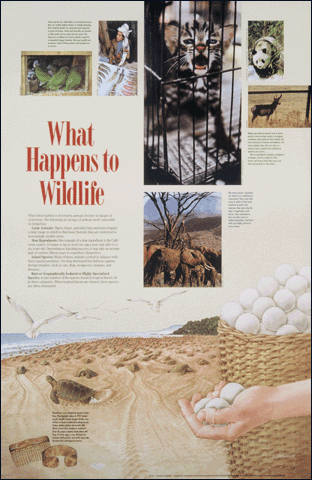 |

|


When their habitat is destroyed, animals become in
danger of extinction. The following are groups of animals most vulnerable
to extinction.
Large Animals: Tigers, bears, and other big carnivores require large range
in which to find food. Instead, they are restricted to increasingly smaller
areas.
Slow Reproducers: One example of a slow reproducer is the California condor.
It begins to lay at most one egg a year only after it is six years old.
Depending on hatching success, it may take an average pair of condors
fifteen years to reproduce themselves.
Island Species: Many of These animals evolved in balance with their natural
predators. Yet they developed few defenses against foreign invaders, such
as cats, dogs, mongooses, humans, and diseases.
Rare or Geographically Isolated or Highly Specialized Species: A vast
number of the species found in tropical forests fit in these categories.
When tropical forests are cleared, these species are often eliminated.
|
| |

Encyclopedia of Biodiversity
*R-SIBL QH541.15 .B56 .E53
Grzimek’s Animal Life Encyclopedia
*R-SIBL QL 3 .G7813

Computer Indexes
General Science Abstracts
Biology Digest
Print Indexes
General Science Index*R-SIBL
Z7401 .G46
Biological Abstracts*R-SIBL QH301 .B37
|

A Voice for Wildlife by Victor B. Scheffer
JSE 99-1087
The Root Causes of Biodiversity Loss
ed. by Alexander Wood
JSE 00-2272
Status and Trends of the Nation’s Biological Resources
ed. by Michael J. Mac
*R-SIBL QH104 .S74

|